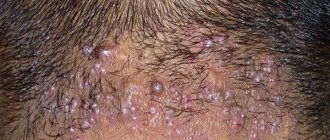Herpes is a very common viral disease, the distinctive feature of which is rashes in the form of groups of blisters on the skin and mucous membranes of a person. These bubbles (vesicles) burst over time, forming wounds that later dry out. There are several types of the virus, the most common being type I (HSV-1) and type II (HSV-2).
HSV-1, also known as herpes simplex, causes rashes mainly in the mouth, lips, face, neck and eyes.
HSV-2 is a genital herpes that affects the skin and mucous membranes in the genital area.
The disease is contagious, the main routes of transmission are contact, through the skin (for example, through kissing), sexual intercourse, through household items, and airborne transmission is also possible. The presence of diseases in which the immune system is weakened (for example, HIV), and treatment with immunosuppressants, for example after organ transplantation, contributes to the manifestation of herpes viral infection.
After the incubation period, painful blisters appear on the skin or mucous membranes and last up to four weeks. The presence of rashes is the main symptom of the disease, but there may be other manifestations similar to influenza and ARVI: chills, sore throat, itching or burning on the skin. After the symptoms disappear, the virus remains in the body and goes into a latent form, in which it can exist throughout the patient’s life. With stress or decreased immunity, the virus can become more active and a relapse occurs. In most cases, herpes is not dangerous to health, but it can have serious consequences for newborns (in the case of primary infection during pregnancy) and in immunodeficiency states.
According to WHO, up to 80% of the Russian population is infected with type I virus and about 20% with type II virus. Moreover, 90% of carriers may not even know about their infection. The presence of infection can only be determined through laboratory diagnostics. One of the most common and effective tests is an analysis for antibodies to herpes viruses types I and II.
Antibodies of the IgM and IgG classes are produced by the body in response to and to fight infection. IgM appears first, they can be detected within a few days after infection, they are a marker of acute infection and can be detected in the blood for up to several weeks.
IgG antibodies to the herpes simplex virus are usually formed 2-3 weeks after infection. The concentration of IgG in the blood increases for several weeks, then stabilizes. When a dormant viral infection is activated, the level of IgG may increase. After suffering an acute illness or as a result of asymptomatic infection, a certain level of IgG remains in a person for the rest of his life.
Detailed description of the study
Herpes simplex virus is a common viral infection caused by the herpes simplex virus (HSV). Most often it occurs in a hidden - latent, asymptomatic - form. The appearance of clinical signs of herpes infection in humans is always associated with a weakening of the body’s immune system, and the stronger the immune disorders, the more severe the disease.
In total, there are about two hundred varieties of the virus, but only 8 of them affect humans. Each type has its own characteristics. Herpes simplex viruses of the first (HSV-1 / HSV-1) and second (HSV-2 / HSV-2) types are the most studied. HSV-1 typically affects the lips, facial skin, and oral mucosa. HSV-2 - genitals.
Infection with herpes simplex virus type 1 in the vast majority of people occurs in early childhood, after the infant has lost the passive immunity received from the mother. The main route of transmission of herpes virus type 1 is contact or household contact. The virus is transmitted through saliva through poorly washed hands and shared objects.
Infection with herpes simplex virus type 2 mainly occurs through sexual contact with an infected partner. Cases of transmission of infection during childbirth have also been described, when a newborn, passing through the birth canal, comes into contact with vaginal secretions containing the virus.
Acute infection after infection may be asymptomatic or have some clinical manifestations.
Characteristic clinical manifestations of the acute form include the formation of small transparent bubbles (vesicles) on the mucous membranes of the mouth or face (HSV-1) or in the genital area (HSV-2). At the site of vesicle formation, a person feels itching and burning.
After the initial infection, the herpes simplex virus remains in the cells of the central nervous system, where its reproduction is restrained by the immune system, but when the immune system is weakened, the virus enters the blood again (relapse, reactivation). As a rule, relapse of infection occurs due to immunodeficiency due to:
- Prolonged exposure to the sun;
- Stress;
- Long-term use of glucocorticosteroid medications;
- Decreased immunity;
- HIV infections.
To diagnose a herpes virus infection, the patient is examined, and laboratory confirmation is also used, which can be carried out using classical laboratory diagnostic methods - the presence of the virus is determined in samples of biomaterial obtained from vesicles. Serological research methods are also used, which detect specific antibodies in the blood serum. Determining the stage of herpes infection is possible by classes of specific antibodies - IgM and IgG.
IgM is produced immediately after infection and serves as a marker of the acute period of the disease, IgG begins to be produced approximately 2-4 weeks after infection and can remain in the blood for many months, indicating the chronic stage of infection.
This study allows us to identify reactivation of the infection, determine the type of virus that caused the disease, and also confirm the preliminary diagnosis (herpes virus infection).
Take a blood test for herpes simplex virus types 1 and 2
Herpes simplex virus (HSV, HSV) is a DNA virus of the herpesvirus family. There are two types of virus: HSV-1 and HSV-2. HSV-1 manifests itself in the form of rashes of small blisters in the mouth and in the oral cavity, eyes, and skin. The herpes virus can be extremely dangerous if it causes the development of meningoencephalitis. Since the virus affects nerve endings, as the infection spreads, it can penetrate the brain. Such conditions are extremely serious and require urgent medical attention. Herpes virus type 1 is extremely common among the population. Sometimes people do not even know that they are infected, because the virus can be present in the body for a long time without causing any changes. The spread of the virus is facilitated by its transmission route - airborne droplets. Usually, in the presence of herpetic eruptions on the oral mucosa, a person becomes a source of viral infection. The virus is also transmitted from the mother of the child. Separately, the sexual route of transmission is distinguished. Type 2 herpes, also called genital herpes, is most often spread this way. Taking into account the peculiarities of sexual life, the types of the virus have recently become cross-functional. This means that rashes on the genitals can be caused by type 1 herpes, which was initially considered labial, and genital herpes, in turn, can cause blisters to appear in the mouth (nasolabial triangle, buccal area). Regardless of how the virus entered the body, it can immediately cause certain manifestations. This is not always a rash on the mucous membrane. For example, during primary infection, an increase in body temperature, weakness, and lack of appetite are often observed; symptoms may resemble the clinical picture of ARVI or influenza. Similar manifestations can be observed during exacerbation of an existing infection. It is very important to understand whether a primary infection or an exacerbation has occurred. This is especially important to know during pregnancy. Indeed, during the initial encounter with the herpes virus, its effect on the fetus can be extremely serious, since this significantly increases the risk of spontaneous abortion, severe damage to the fetus and newborn, and the formation of congenital pathologies of the fetus. In such cases, a decision may be made to terminate the pregnancy for medical reasons. Therefore, it is important to have information about whether a person is currently a carrier of herpes. For women, additional diagnostics are also carried out during pregnancy. The examination complex for determining herpes infection includes an analysis to detect class G antibodies to herpes type 1 and 2. Like all antibodies of this class, they indicate a past infection. During primary infection, these antibodies appear after class M antibodies and remain for life in one concentration or another. During an exacerbation of the disease, as in remission, they will also be observed, but either together with class M antibodies (exacerbation) or without them (outside the exacerbation). If it is important to determine the duration of infection, an additional study of the avidity index may be recommended.
Indications for the study:
· In the complex of diagnosing herpetic infection · Screening examination of people who are sexually active · Screening examination of married couples at the stage of pregnancy planning · Screening examination of pregnant women, mainly in the first trimester of pregnancy
Decoding the results:
· Positive result. In case of detection of Ig G to herpes virus type 1 or 2, it can indicate different types of infection - acute or chronic infection caused by type 1 herpes virus, acute or chronic infection caused by type 2 herpes virus. In such cases, it is important to evaluate the content of class M antibodies. If they are present, we can talk about the acute phase. If there is a need to clarify the type of virus, additional diagnostics may be prescribed. · Negative result. The absence of class G antibodies most often indicates the absence of a herpes infection caused by a type 1 or 2 virus. But do not forget that during primary infection in the first days of the disease, Ig G may not yet have time to be developed. In such cases, it is important to check Ig M, which will definitely be detected. Since absolutely everyone is susceptible to infection with herpes, at any period of life, if the result is negative (absence of antibodies of both classes), repeated examination may be indicated in the future if necessary.
It should be noted that children, elderly people, and people with weakened immune systems are more susceptible to infection. In turn, the herpes virus can affect the likelihood of contracting other infections, in particular, the risk of HIV infection increases.
Types and routes of HSV infection
The content of the article
Herpes is a common infection that affects people of all ages. Most of those infected have already developed the disease in some way, and some people become virus carriers, spreading the disease. Infection with herpes occurs through sexual and household contacts, in utero or during childbirth from a sick mother, as well as through breast milk.
The herpes virus (HSV) remains in the human body for life, periodically being dormant (from a month to several years) or active, causing small rashes on the mucous membranes, which subsequently merge, forming crusty ulcers. With an extremely low level of immunity, a generalized form of herpes occurs with damage to internal organs.
There are 8 types of infection. The viruses are interrelated and can be detected simultaneously in one patient. Most often, two types of viruses are detected in humans:
- Type 1 virus - herpetic fever (oral herpes) - most often appears on the lips, but can also cause the genital form. Transmitted orally. The infection affects 67% of people.
- Type 2 virus - genital and anal herpes - the virus affects the genitals (genitals), causes herpes in newborns and the disseminated form - herpes zoster, spreading over the face and body. Transmitted sexually. 11% of people are infected.
The first type of herpes in most cases affects a person in preschool age, the second type - with the onset of sexual activity. The prevalence of household infection is extremely high, since the virus persists for a certain time on household items, door handles, and wet surfaces.
What do the test results mean?
A negative result indicates the absence of antibodies to herpes viruses types I and II, which is possible if the body has not previously been in contact with the virus. Also, antibodies are not detected if little time has passed after infection and the body has not yet had time to produce IgG class immunoglobulins. A positive result indicates a current or past infection. If the result is questionable (borderline antibody level), it is recommended to be tested for IgM antibodies to herpes simplex virus types I and II and carry out a control test for IgG after a few weeks.
Preparing for a herpes test
The biomaterial for analysis is not only blood plasma, but also scrapings of the epithelium from the affected mucosa, as well as saliva and urine. To avoid unreliable results, you should prepare for collecting material for research.
- Before taking a scraping from the urogenital area, you must stop sexual intercourse two days before the test and not urinate for two hours immediately before the procedure.
- Genital material is collected from women only after the end of menstruation.
- For other forms of research, morning urine and blood from a vein are donated on an empty stomach. At the same time, you should not take alcohol, spicy or fatty foods the day before.
Consequences of herpes infection
A characteristic feature of the virus is that this infection cannot be removed from the body by modern drugs, but doctors can significantly ease its course or extinguish the infection for a while, which is especially important during pregnancy.
Recent scientific research has shown that herpes is not at all harmless, as previously thought. The activity of the virus in the body can cause severe consequences:
- spontaneous termination of pregnancy (miscarriage) and premature birth;
- fading of pregnancy, increase in infant mortality by 50%;
- pathologies of the eyes and brain in the fetus;
- with simultaneous infection with the papilloma virus, the likelihood of developing cervical cancer significantly increases;
- the possibility of activation of HIV infection in virus carriers increases.
The infection is included in the group of infections potentially dangerous to the fetus (TORCH), therefore the detection of specific immunoglobulins (IgM. IgG and IgA) in the blood of the expectant mother serves as the basis for consulting a doctor about the possibility of continuing the pregnancy.
Which herpes test is better?
In modern practice, several methods for determining HSV are used:
- Culture of genital smears using cell culture followed by microscopic examination of the results obtained.
- The immunofluorescence reaction shows the presence of the virus by the reaction of test antibodies. The basis of the study is blood serum.
- PCR analysis - laboratory technicians isolate DNA fragments of the virus. The following biomaterials are used for research: scrapings from the urogenital area, morning urine, saliva, and blood serum.
- ELISA - enzyme-linked immunosorbent assay. Blood serum is examined.
To increase the reliability of the analysis, it is recommended to use not one, but several methods simultaneously or conduct repeated studies. This is due to the behavior of the virus in the body; in particular, HSV can be detected in the blood only several weeks after the alleged infection. Specific antibodies appear in different sequences and at different phases of the disease - IgM appears on the 5th day after infection and reaches a peak by the 20th day, IgG is detected from the 14th day, IgA - at a later date. The combination of antibodies shows the degree of activity of the virus and its dynamics, so the analysis is carried out at intervals - after 10-12 days.
Who should be tested for herpes?
In cases where there are obvious signs of disease or there is a suspicion of infection, a complex of studies of the biomaterial is carried out in the laboratory. In the remission phase and immediately after infection, the virus is difficult to recognize, so a combination of analysis methods or a series of repeated studies is carried out.
A gynecologist, urologist, and dermatologist (venerologist) are referred for testing for herpes. The analysis is prescribed for obvious signs of the disease - blistering rashes on the mucous membranes and lips, their fusion and the appearance of crusts, burning and itching in places of changes in the mucous membrane.
Women who become pregnant or are planning to have a child are required to be tested for this infection in order to prevent serious consequences. Newborns from sick mothers are also examined.
Carriers of the HIV and papilloma viruses are also tested for herpes in order to take into account its influence in further treatment tactics.
References
- Clinical guidelines “Herpes simplex (HS) in adults” approved. Ministry of Health of the Russian Federation, 2016. - 31 p.
- Belyaletdinova, I.Kh., Golosnaya, G.S., Mitrofanova, I.V. and others - Clinical and laboratory characteristics of encephalitis caused by the herpes simplex virus in children. - Treatment and prevention, 2016. - No. 4 (20). — P.64-68.
- Khryanin, A.A. Herpes under the pillow. Prevalence of herpes simplex virus in the Russian population: long-term monitoring. – STATUSPRAESENS. Gynecology, obstetrics, infertile marriage, 2013. - No. 6. — P.69-76.
- Mathew, J., Sapra, A. Herpes simplex type 2. - StatPearls Publishing, 2022.
Symptoms of herpes infection
If you suspect a possible infection, you should undergo examination, even if there are no signs of herpes. In most cases, the disease is asymptomatic.
Exacerbations of the disease are usually associated with stress and fatigue, decreased immunity and colds. The activity of the virus is manifested by characteristic symptoms:
- sores and crusts on the lips;
- blistering rashes on the genitals, around the anus;
- fever;
- pain and itching in areas where the mucous membrane is affected.
Manifestations of the disease affect the mucous membranes of the genitals and oral cavity. The first type of virus, when activated, forms primary gingivostomatitis or recurrent herpes, the second type becomes the source of genital herpes. Advanced disease is not limited to spreading on the lips. Herpes can colonize all mucous membranes, affecting the throat, nasal cavity, and internal organs. Herpes rashes are also possible on the face and entire body. The herpes test detects all types of infection.








